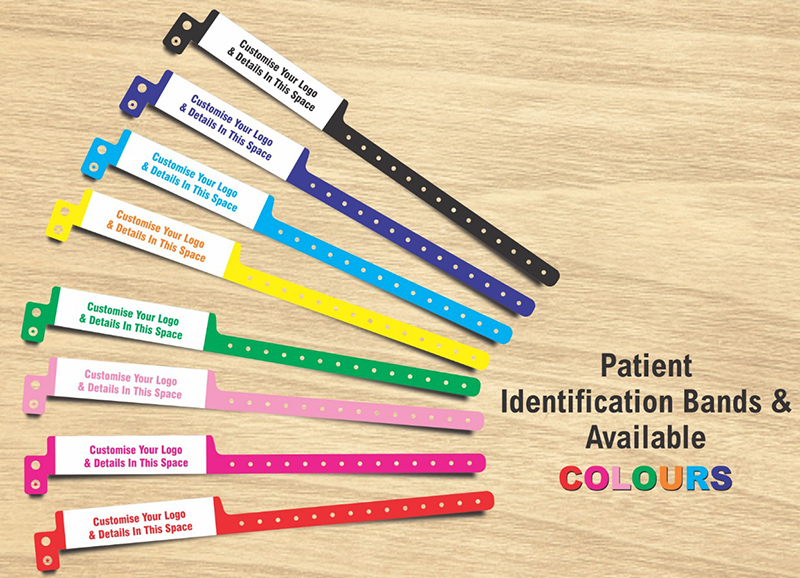Choosing the Right Materials for Your Patient Identification Band: A Step-by-Step Guide
Checking Out the Different Types of Patient Identification Band Utilized in Medical Facilities
In the complex world of healthcare, the important function of Patient Identification bands commonly goes undetected. These bands, varying from easy paper wristbands to sophisticated RFID bands, develop the backbone of Patient safety protocols, guaranteeing precision in Patient Identification. The vast diversity of these bands, each with its unique advantages and limitations, is typically ignored. As we navigate through this topic, one may acquire insight right into the subtle intricacies and critical significance of such bands in clinical facilities.
Recognizing the Value of Patient Identification Bands
While they may feel like simple accessories, Patient Identification bands play a crucial function in medical facilities. These bands act as an essential tool for validating Patient identification, preventing clinical mistakes connected to misidentification. The bands usually present vital details such as the Patient's name, age, blood group, and any kind of known allergies. They enable health care specialists to promptly access this crucial info, therefore facilitating prompt and precise clinical therapy. Patient Identification bands also aid in improving management jobs, ensuring precise record-keeping and payment. Regardless of their simplicity, these bands embody the principle of Patient safety, a foundation of quality health care. Without them, the danger of clinical errors, and as a result, Patient harm, may significantly enhance.
Conventional Paper Wristbands: Their Usage and Limitations
Standard paper wristbands have actually been a staple in Patient Identification across various clinical facilities. While their usage prevails, they nurture specific restrictions that may impact their efficiency in Patient management. This section will concentrate on the scope of their application and the fundamental disadvantages connected with their usage.
Paper Wristbands: Usage Extent
In the realm of Patient Identification, paper wristbands have long held a vital function. These bands are typically made use of in outpatient settings, where the Patient's remain is temporary. The wristbands have essential info such as the Patient's name, date of birth, and a distinct Identification number. This easy, yet efficient system, permits physician to swiftly and accurately identify people, ensuring the correct therapy is provided. Paper wristbands are likewise utilized in emergency scenarios, where fast Identification is critical. Their usage reaches events like blood contribution drives and mass inoculation programs, further highlighting their convenience. Despite innovations in technology, the simple paper wristband continues to be a reputable and cost-efficient solution for Patient Identification in numerous healthcare situations.
Limitations of Paper Wristbands
In spite of their extensive usage, paper wristbands are not without their downsides. In addition, paper wristbands typically lack the technological capabilities of even more modern-day options, such as barcoding or RFID chips, limiting their functionality to simply displaying created information. Paper wristbands can trigger discomfort or skin irritability to some clients, specifically when put on for prolonged durations.
Barcoded Wristbands: Improvements in Patient Identification
While Patient Identification has long been a vital facet of medical care, the arrival of barcoded wristbands signifies a useful reference substantial leap ahead. These bands utilize the simplicity of barcoding innovation, permitting for Patient info to be promptly scanned and accessed. They improve the rate and accuracy of Patient Identification, reducing the danger of clinical errors associated with misidentification. Barcoded wristbands are cost-effective, simple to produce, and remove handwriting errors common with hands-on systems. They are not without constraints. While they provide improvements over traditional bands, the barcode can come to be used or smudged, making it unreadable. Despite this, barcoded wristbands continue to be an essential tool in modern-day medical care setups, representing the junction of modern technology and Patient treatment.
Superhigh Frequency Identification (RFID) Bands: a Step In The Direction Of Futuristic Healthcare
The development of Patient Identification bands has actually brought about the development of Radio Frequency Identification (RFID) Bands (patient identification band). These innovative gadgets present crucial benefits for medical care centers, supplying a more effective and technically progressed means of Patient Identification. The execution of RFID in medical care is a significant step in the direction of a more futuristic technique to Patient management and safety
Recognizing RFID Bands

RFID Bands: Key Advantages
Mainly, these bands boost Patient safety by offering precise, rapid Identification, thus minimizing clinical mistakes. RFID bands can store a large amount of Patient information, consisting of clinical background and allergic reactions, enabling personalized care. Generally, RFID bands stand for a substantial advancement in Patient Identification technology, benefiting both individuals and health care providers.
Implementing RFID in Health Care
These bands supply a seamless means to track and recognize patients, ensuring their safety and improving performance in therapy procedures. RFID bands minimize medical mistakes by supplying accurate Patient Identification, which is important in stopping misdiagnosis or wrong medication administration. Thus, the execution of RFID bands is a substantial action towards improving pop over here Patient security and health care shipment.

Color-Coded Wristbands: Helping in Quick and Accurate Diagnosis
In the busy environment of a clinical facility, color-coded wristbands have actually emerged as important devices for swift and specific Identification of a patient's clinical condition. These wristbands, put on by people, carry specific shades that correspond to different clinical conditions or standings. This system is developed to supply instant aesthetic hints to healthcare service providers, enhancing Patient safety and care top quality.
Techniques for Reliable Implementation and Monitoring of Patient ID Bands
Accomplishing optimum use of Patient Identification bands requires a well-structured approach for their implementation and administration. Patient education and learning is also essential; clients have to recognize the function of the bands Related Site and the need for their continuous wear. It's necessary to have a backup plan in area, such as barcode scanning or biometrics, to make certain that Patient Identification is never ever compromised.
Conclusion
Patient Identification bands are important in clinical facilities to make sure safety and security and precision. Effective application and monitoring of these bands can significantly decrease clinical mistakes, boost efficiency, and enhance general Patient care.
These bands, varying from easy paper wristbands to sophisticated RFID bands, develop the foundation of Patient safety and security protocols, making sure accuracy in Patient Identification.The evolution of Patient Identification bands has brought about the development of Radio Frequency Identification (RFID) Bands. Generally, RFID bands stand for a substantial innovation in Patient Identification innovation, profiting both clients and medical care service providers.
RFID bands minimize medical errors by supplying exact Patient Identification, which is critical in avoiding misdiagnosis or incorrect medicine management. Patient education is likewise important; individuals must understand the purpose of the bands and the need for their constant wear.